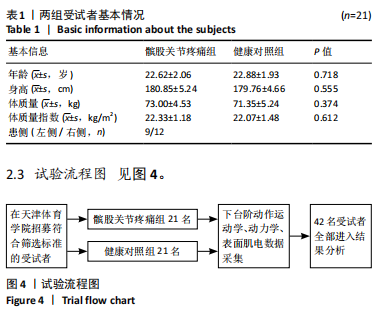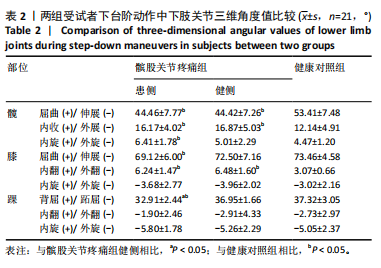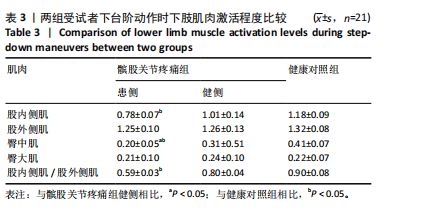[1] XU J, CAI Z, CHEN M, et al. Global research trends and hotspots in patellofemoral pain syndrome from 2000 to 2023: a bibliometric and visualization study. Front Med (Lausanne). 2024;11:1370258.
[2] GLAVIANO NR, BAZETT-JONES DM, BOLING MC. Pain severity during functional activities in individuals with patellofemoral pain: A systematic review with meta-analysis. J Sci Med Sport. 2022;25(5):399-406.
[3] HOTT A, BROX JI, PRIPP AH, et al. Predictors of pain, function, and change in patellofemoral pain. Am J Sports Med. 2020;48(2):351-358.
[4] THOMAS MJ, WOOD L, SELFE J, et al. Anterior knee pain in younger adults as a precursor to subsequent patellofemoral osteoarthritis: a systematic review. BMC Musculoskelet Disord. 2010;11:201.
[5] ROCHA EAB, COSTA DE ASSIS SJ, MAIA DFM, et al. Risk factors for patellofemoral pain in the military: systematic review with meta-analysis. J Athl Train. 2024. doi: 10.4085/1062-6050-0526.23.
[6] KAYLL SA, HINMAN RS, BRYANT AL, et al. Do biomechanical foot-based interventions reduce patellofemoral joint loads in adults with and without patellofemoral pain or osteoarthritis? A systematic review and meta-analysis. Br J Sports Med. 2023;57(13):872-881.
[7] CROSSLEY KM, VAN MIDDELKOOP M, BARTON CJ, et al. Rethinking patellofemoral pain: Prevention, management and long-term consequences. Best Pract Res Clin Rheumatol. 2019;33(1):48-65.
[8] CULVENOR AG, VAN MIDDELKOOP M, MACRI EM, et al. Is patellofemoral pain preventable? A systematic review and meta-analysis of randomised controlled trials. Br J Sports Med. 2021;55(7):378-384.
[9] KIM S, WU Y, GLAVIANO NR, et al. Physical activity levels in persons with patellofemoral pain: a systematic review and meta-analysis. Sports Health. 2024. doi: 10.1177/19417381241264494.
[10] LANKHORST NE, BIERMA-ZEINSTRA SM, VAN MIDDELKOOP M. Factors associated with patellofemoral pain syndrome: a systematic review. Br J Sports Med. 2013;47(4):193-206.
[11] POWERS CM, WITVROUW E, DAVIS IS, et al. Evidence-based framework for a pathomechanical model of patellofemoral pain: 2017 patellofemoral pain consensus statement from the 4th International Patellofemoral Pain Research Retreat, Manchester, UK: part 3. Br J Sports Med. 2017;51(24): 1713-1723.
[12] CELIK D, ARGUT SK, TÜRKER N, et al. The effectiveness of superimposed neuromuscular electrical stimulation combined with strengthening exercises on patellofemoral pain: A randomized controlled pilot trial. J Back Musculoskelet Rehabil. 2020;33(4):693-699.
[13] FERREIRA AS, DE OLIVEIRA SILVA D, BARTON CJ, et al. Impaired isometric, concentric, and eccentric rate of torque development at the hip and knee in patellofemoral pain. J Strength Cond Res. 2021;35(9):2492-2497.
[14] FAN C, NIU Y, WANG F. Local torsion of distal femur is a risk factor for patellar dislocation. J Orthop Surg Res. 2023;18(1):163.
[15] GLAVIANO NR, SALIBA S. Differences in gluteal and quadriceps muscle activation during weight-bearing exercises between female subjects with and without patellofemoral pain. J Strength Cond Res. 2022;36(1):55-62.
[16] MIRZAIE GH, RAHIMI A, KAJBAFVALA M, et al. Electromyographic activity of the hip and knee muscles during functional tasks in males with and without patellofemoral pain. J Bodyw Mov Ther. 2019;23(1):54-58.
[17] FOX A, FERBER R, SAUNDERS N, et al. Gait kinematics in individuals with acute and chronic patellofemoral pain. Med Sci Sports Exerc. 2018;50(3): 502-509.
[18] HO KY, BARRETT T, CLARK Z, et al. Comparisons of trunk and knee mechanics during various speeds of treadmill running between runners with and without patellofemoral pain: a preliminary study. J Phys Ther Sci. 2021;33(10):737-741.
[19] DE BLEECKER C, VERMEULEN S, DE BLAISER C, et al. Relationship between jump-landing kinematics and lower extremity overuse injuries in physically active populations: a systematic review and meta-analysis. Sports Med. 2020;50(8):1515-1532.
[20] RHODE C, LOUW QA, LEIBBRANDT DC, et al. Joint position sense in individuals with anterior knee pain. S Afr J Physiother. 2021;77(1):1497.
[21] CROSSLEY KM, ZHANG WJ, SCHACHE AG, et al. Performance on the single-leg squat task indicates hip abductor muscle function. Am J Sports Med. 2011;39(4):866-873.
[22] ALMEIDA GP, SILVA AP, FRANÇA FJ, et al. Relationship between frontal plane projection angle of the knee and hip and trunk strength in women with and without patellofemoral pain. J Back Musculoskelet Rehabil. 2016;29(2):259-266.
[23] PRIORE LB, AZEVEDO FM, PAZZINATTO MF, et al. Influence of kinesiophobia and pain catastrophism on objective function in women with patellofemoral pain. Phys Ther Sport. 2019;35:116-121.
[24] HOGLUND LT, HULCHER TA, AMABILE AH. Males with patellofemoral pain have altered movements during step-down and single-leg squatting tasks compared to asymptomatic males: A cross-sectional study. Health Sci Rep. 2024;7(6):e2193.
[25] MORITA ÂK, TAVELLA NAVEGA M. Women with patellofemoral pain show changes in trunk and lower limb sagittal movements during single-leg squat and step-down tasks. Physiother Theory Pract. 2024;40(9):1933-1941.
[26] PIVA SR, GOODNITE EA, CHILDS JD. Strength around the hip and flexibility of soft tissues in individuals with and without patellofemoral pain syndrome. J Orthop Sports Phys Ther. 2005;35(12):793-801.
[27] KIM S, PARK J. Patients with chronic unilateral anterior knee pain experience bilateral deficits in quadriceps function and lower quarter flexibility: a cross-sectional study. Physiother Theory Pract. 2022;38(13):2531-2543.
[28] 王芗斌,刘燕平,苏娟,等.《国际功能、残疾和健康分类•髌股关节疼痛》临床实践指南(二)[J].康复学报,2021;31(3):177-199.
[29] SILVA DDE O, BRIANI RV, PAZZINATTO MF, et al. Q-angle static or dynamic measurements, which is the best choice for patellofemoral pain? Clin Biomech (Bristol). 2015;30(10):1083-1087.
[30] IMPELLIZZERI FM, RAMPININI E, MAFFIULETTI N, et al. A vertical jump force test for assessing bilateral strength asymmetry in athletes. Med Sci Sports Exerc. 2007;39(11):2044-2050.
[31] NAKAGAWA TH, MORIYA ÉT, MACIEL CD, et al. Frontal plane biomechanics in males and females with and without patellofemoral pain. Med Sci Sports Exerc. 2012;44(9):1747-1755.
[32] NAKAGAWA TH, MORIYA ET, MACIEL CD, et al. Trunk, pelvis, hip, and knee kinematics, hip strength, and gluteal muscle activation during a single-leg squat in males and females with and without patellofemoral pain syndrome. J Orthop Sports Phys Ther. 2012;42(6):491-501.
[33] AMINAKA N, PIETROSIMONE BG, ARMSTRONG CW, et al. Patellofemoral pain syndrome alters neuromuscular control and kinetics during stair ambulation. J Electromyogr Kinesiol. 2011;21(4):645-651.
[34] WALLIS JA, RODDY L, BOTTRELL J, et al. A systematic review of clinical practice guidelines for physical therapist management of patellofemoral pain. Phys Ther. 2021;101(3):pzab021.
[35] COLLINS NJ, BARTON CJ, VAN MIDDELKOOP M, et al. 2018 Consensus statement on exercise therapy and physical interventions (orthoses, taping and manual therapy) to treat patellofemoral pain: recommendations from the 5th International Patellofemoral Pain Research Retreat, Gold Coast, Australia, 2017. Br J Sports Med. 2018;52(18):1170-1178.
[36] GAITONDE DY, ERICKSEN A, RObbins rc. patellofemoral pain syndrome. Am fam physician. 2019;99(2):88-94.
[37] DE OLIVEIRA SILVA D, BARTON CJ, PAZZINATTO MF, et al. Proximal mechanics during stair ascent are more discriminate of females with patellofemoral pain than distal mechanics. Clin Biomech (Bristol). 2016;35:56-61.
[38] 杨辰,万祥林,冯茹,等.膝痛对髌股关节痛业余跑者跑步和落地起跳缓冲期膝关节生物力学特征的影响[J].中国体育科技,2022,58(2):62-68.
[39] SHERMAN SL, PLACKIS AC, NUELLE CW. Patellofemoral anatomy and biomechanics. Clin Sports Med. 2014;33(3):389-401.
[40] BROUWER GM, VAN TOL AW, BERGINK AP, et al. Association between valgus and varus alignment and the development and progression of radiographic osteoarthritis of the knee. Arthritis Rheum. 2007;56(4):1204-1211.
[41] LEE TQ, MORRIS G, CSINTALAN RP. The influence of tibial and femoral rotation on patellofemoral contact area and pressure. J Orthop Sports Phys Ther. 2003;33(11):686-693.
[42] POWERS CM. The influence of abnormal hip mechanics on knee injury: a biomechanical perspective. J Orthop Sports Phys Ther. 2010;40(2):42-51.
[43] POLLARD CD, SIGWARD SM, POWERS CM. Limited hip and knee flexion during landing is associated with increased frontal plane knee motion and moments. Clin Biomech (Bristol). 2010;25(2):142-146.
[44] WILLSON JD, DAVIS IS. Utility of the frontal plane projection angle in females with patellofemoral pain. J Orthop Sports Phys Ther. 2008;38(10):606-615.
[45] MCKENZIE K, GALEA V, WESSEL J, et al. Lower extremity kinematics of females with patellofemoral pain syndrome while stair stepping. J Orthop Sports Phys Ther. 2010;40(10):625-632.
[46] HUBERTI HH, HAYES WC. Patellofemoral contact pressures. The influence of q-angle and tendofemoral contact. J Bone Joint Surg Am. 1984;66(5):715-724.
[47] 杨辰,曲峰,刘卉,等. 髌股关节痛业余跑者性别特异的下肢生物力学特征[J].医用生物力学,2020,35(6):672-678.
[48] MACRUM E, BELL DR, BOLING M, et al. Effect of limiting ankle-dorsiflexion range of motion on lower extremity kinematics and muscle-activation patterns during a squat. J Sport Rehabil. 2012;21(2):144-150.
[49] 董友清,魏子轩,吴海鸥,等.不同类型女性髌股关节疼痛综合征患者的下肢生物力学特征[J].中国组织工程研究,2025,29(21):4458-4468.
[50] EMAMVIRDI M, HOSSEINZADEH M, LETAFATKAR A, et al. Comparing kinematic asymmetry and lateral step-down test scores in healthy, chronic ankle instability, and patellofemoral pain syndrome female basketball players: a cross-sectional study. Sci Rep. 2023;13(1):12412.
[51] WAITEMAN MC, BRIANI RV, LOPES HS,et al. People with patellofemoral pain have bilateral deficits in physical performance regardless of pain laterality. J Athl Train. 2024;59(11):1110-1117.
[52] 吕福祥,张泽根,黄雪晴,等.高水平太极拳运动员下肢功能不对称与蹬脚动作表现关联性研究[J].武汉体育学院学报,2024,58(6):89-96.
[53] 杨晓巍,姚英策,吴菁,等.肌肉电刺激结合肌力训练对髌股疼痛综合征人群单腿下蹲动作生物力学特征的影响[J].体育科学,2023,43(8):52-60+66.
[54] LISKA F, VON DEIMLING C, OTTO A, et al. Distal femoral torsional osteotomy increases the contact pressure of the medial patellofemoral joint in biomechanical analysis. Knee Surg Sports Traumatol Arthrosc. 2019;27(7): 2328-2333.
[55] CHEN S, CHANG WD, WU JY, et al. Electromyographic analysis of hip and knee muscles during specific exercise movements in females with patellofemoral pain syndrome: An observational study. Medicine (Baltimore). 2018;97(28):e11424.
[56] BRIANI RV, DE OLIVEIRA SILVA D, FLÓRIDE CS, et al. Quadriceps neuromuscular function in women with patellofemoral pain: Influences of the type of the task and the level of pain. PLoS One. 2018;13(11):e0207421.
[57] SELKOWITZ DM, BENECK GJ, POWERS CM. Comparison of electromyographic activity of the superior and inferior portions of the gluteus maximus muscle during common therapeutic exercises. j orthop sports phys ther. 2016;46(9):794-799.
[58] WILLSON JD, KERNOZEK TW, ARNDT RL, et al. Gluteal muscle activation during running in females with and without patellofemoral pain syndrome. Clin Biomech (Bristol). 2011;26(7):735-740.
[59] PAYNE K, PAYNE J, LARKIN TA. Patellofemoral pain syndrome and pain severity is associated with asymmetry of gluteus medius muscle activation measured via ultrasound. Am J Phys Med Rehabil. 2020;99(7):595-601.
[60] DE OLIVEIRA SILVA D, MAGALHÃES FH, FARIA NC, et al. Lower amplitude of the hoffmann reflex in women with patellofemoral pain: thinking beyond proximal, local, and distal factors. arch phys med Rehabil. 2016;97(7):1115-1120. |


